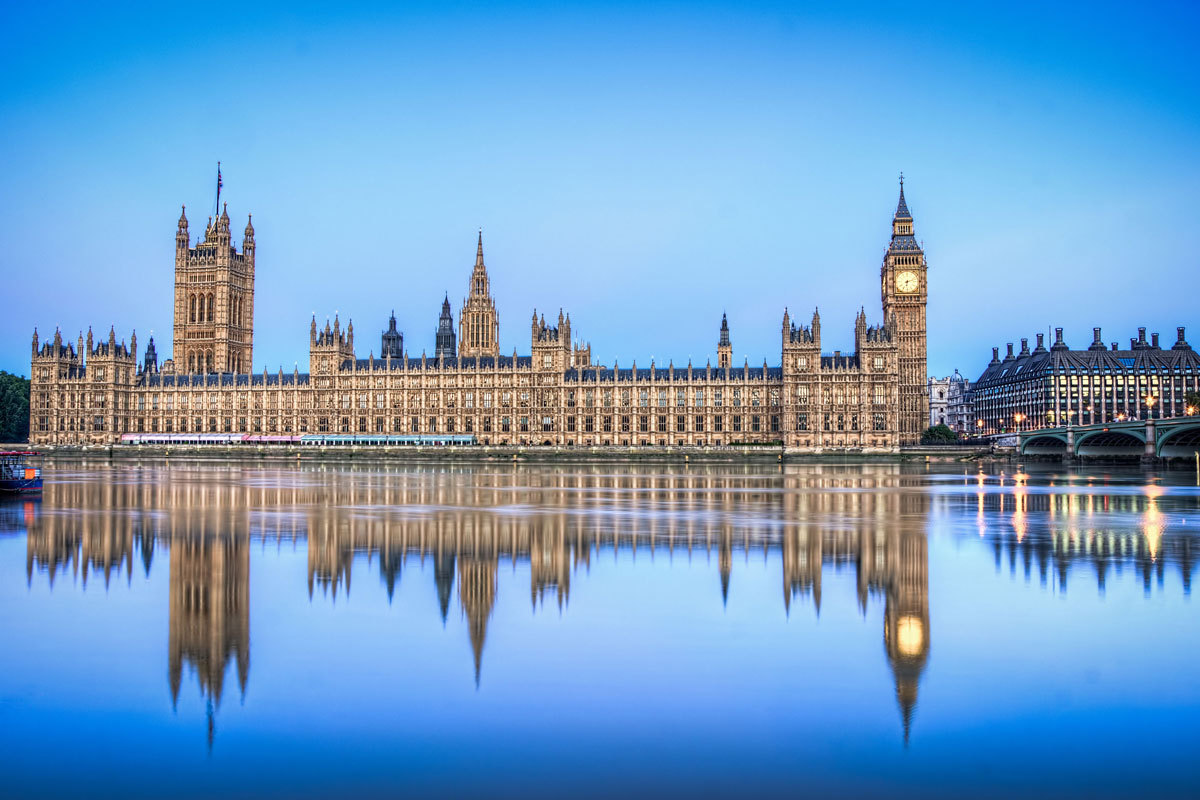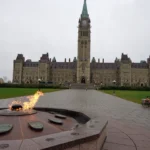
Welcome to the historic Palace of Westminster, an architectural marvel nestled on the banks of the River Thames in the heart of London. With its roots reaching back to the 19th century, this iconic structure, designed by Sir Charles Barry and Augustus Pugin, stands as a testament to the enduring spirit of British democracy and governance. From the symbolic laying of the foundation stone in 1840 to the intricate details of the Gothic Revival style, the Palace of Westminster weaves a rich tapestry of history, politics, and culture. Join us as we delve into 25 fascinating facts and numerical trivia that unveil the captivating story behind this world-renowned parliamentary institution.
Foundation Stone Laid: The Palace of Westminster’s foundational stone was ceremoniously laid on October 23, 1840, marking the initiation of a monumental construction project that would redefine the London skyline and the British parliamentary landscape. This symbolic act not only set the physical groundwork for the grand structure but also represented a pivotal moment in the nation’s history, showcasing the resilience and vision of a society eager to rebuild after the devastating fire that consumed the original palace in 1834.
Architect: Renowned architect Sir Charles Barry, in collaboration with the talented Augustus Pugin, was responsible for the design of the Palace of Westminster. Barry’s choice of the Gothic Revival style was influenced by a desire to evoke a sense of historical continuity and national identity. The collaborative effort between Barry and Pugin resulted in a masterpiece that seamlessly blended aesthetics with functionality, making the palace an enduring symbol of Victorian architectural prowess.
Construction Time: The construction of the Palace of Westminster spanned an impressive three decades, commencing in 1840 and culminating in 1870. This prolonged construction period reflects the complexity and scale of the project, as well as the challenges faced during the mid-19th century, including technological limitations and occasional interruptions such as the Crimean War. The extended timeline only adds to the historical significance of the palace, showcasing the dedication and perseverance required to bring such an ambitious architectural venture to fruition.
Gothic Revival Style: The Palace of Westminster stands as a testament to the Gothic Revival architectural movement of the 19th century. This style, characterized by pointed arches, intricate tracery, and soaring spires, aimed to revive medieval design elements. Sir Charles Barry’s choice of the Gothic Revival style for the palace was a deliberate nod to Britain’s historical and cultural roots, fostering a connection between the past, present, and future within the walls of this iconic parliamentary institution.
Big Ben: The famous clock tower, affectionately known as Big Ben, became a symbol of London and the United Kingdom. Contrary to popular belief, “Big Ben” technically refers to the Great Bell housed within the tower. The clock, a marvel of Victorian engineering, started ticking on May 31, 1859. Big Ben’s imposing presence and the resonant chimes have echoed through the centuries, serving not only as a timekeeping mechanism but also as an auditory landmark for Londoners and visitors alike.
Completion of Big Ben: The culmination of meticulous craftsmanship and engineering, the completion of Big Ben marked a historic moment in the Palace of Westminster’s timeline. On May 31, 1859, the resounding chimes of the clock tower announced its operational readiness, echoing through the heart of London. Big Ben quickly became synonymous with the city itself, a cultural icon standing as a testament to the technological advancements of the Victorian era and the enduring legacy of the Palace of Westminster.
Clock Faces: Dominating the London skyline, each of the four clock faces adorning the Elizabeth Tower measures an impressive 23 feet (7 meters) in diameter. This monumental size not only ensures visibility from great distances but also contributes to the tower’s commanding presence. The clock faces, adorned with intricate numerals and hands, are marvels of precision engineering, showcasing the commitment to excellence that characterized the entire construction of the Palace of Westminster.
Bell Weight: The resonant heartbeat of the Elizabeth Tower, Big Ben’s Great Bell, boasts an imposing weight of 13.7 tons. This colossal mass contributes to the deep, resonant tones that have become synonymous with the passage of time in the heart of London. The sheer weight of the bell underscores the magnitude of the engineering feats accomplished during the construction of the clock tower, solidifying its status as a landmark that transcends its utilitarian function.
Tower Height: Rising majestically to a height of 316 feet (96 meters), the Elizabeth Tower (Big Ben) commands attention on the London skyline. This towering height not only serves a practical purpose in facilitating the visibility of the clock faces but also contributes to the overall grandeur of the palace complex. The vertical ascent of the tower, coupled with its architectural finesse, reflects the ambition and vision that characterized the design and construction of the Palace of Westminster.
Fire of 1834: The genesis of the Palace of Westminster’s reconstruction was the devastating fire that engulfed the original structure on October 16, 1834. This tragic event served as a catalyst for the architectural renaissance led by Sir Charles Barry. The fire, while causing substantial destruction, paved the way for the emergence of a new, more resilient symbol of British democracy. The Palace of Westminster, rising from the ashes of adversity, stands as a testament to the indomitable spirit and unwavering commitment to progress that defines the nation’s history.
River Thames Location: The strategic location of the Palace of Westminster on the banks of the River Thames adds to its historical and aesthetic significance. The proximity to the river not only facilitated transportation during the construction phase but also symbolizes the connection between the political heart of the nation and its economic lifeblood. Overlooking the river, the palace reflects the symbiotic relationship between the government and the people it serves, with the flowing waters mirroring the ebb and flow of political currents.
Function: Serving as the primary meeting place for the United Kingdom Parliament, the Palace of Westminster is not merely an architectural marvel but a functional hub of legislative activity. The chambers within the palace, including the House of Commons and the House of Lords, have witnessed countless debates, decisions, and pivotal moments in British history. The very design and layout of the palace reflect the democratic ideals and governance structure that have evolved over centuries within its storied walls.
Commons and Lords Chambers: At the heart of parliamentary proceedings are the House of Commons and the House of Lords, housed within the Palace of Westminster. These chambers serve distinct functions, with the Commons representing elected members and the Lords comprising appointed and hereditary members. The juxtaposition of these two chambers within the palace emphasizes the balance and collaboration integral to the British parliamentary system, showcasing the architectural embodiment of democratic governance.
Rooms and Corridors: Boasting over 1,000 rooms and an extensive two miles (3.2 km) of corridors, the Palace of Westminster is a labyrinthine architectural marvel. Beyond the grandeur of its iconic chambers lie the offices, committee rooms, and administrative spaces that form the operational backbone of parliamentary activities. This intricate network of rooms and corridors reflects the complexity of the legislative process and the diverse functions accommodated within the palace’s historic walls.
Victoria Tower: The regal Victoria Tower, standing proudly at the southern end of the palace, reaches a height of 323 feet (98.5 meters). This tower, adorned with intricate detailing and statuary, is not merely a decorative element but houses the Parliamentary Archives. The combination of architectural splendor and functional significance encapsulates the dual nature of the Palace of Westminster, where aesthetics seamlessly intertwine with practicality and historical preservation.
Statues and Busts: Scattered throughout the Palace of Westminster are numerous statues and busts paying homage to figures of historical and political importance. From Winston Churchill to Oliver Cromwell and Nelson Mandela, these sculptures serve as visual reminders of the individuals who have played pivotal roles in shaping the course of British history. The presence of these monuments within the palace underscores its role as a living repository of national memory and a testament to the diverse influences that have shaped the nation.
Sovereign’s Entrance: The Sovereign’s Entrance, used by the monarch during the State Opening of Parliament, stands as a testament to the ceremonial aspects of British governance. Constructed with Portland stone and adorned with sculptures, this entrance is a blend of architectural elegance and symbolic significance. The elaborate design of the Sovereign’s Entrance highlights the connection between the monarchy and the parliamentary system, embodying the ceremonial traditions that have evolved over centuries.
Bombing in WWII: During the tumultuous years of World War II, the Palace of Westminster faced the devastating impact of the Blitz. Despite sustaining damage, the essential structure, including the historic Westminster Hall, remained resilient. The endurance of the palace during wartime symbolizes its enduring importance and the indomitable spirit of the British people, who continued to uphold democratic ideals even in the face of external threats.
Victoria Tower Records Office: Within the soaring heights of the Victoria Tower lies the Parliamentary Archives, housing historical records dating back to 1497. This repository of knowledge and documentation serves as a testament to the continuity of parliamentary governance in the United Kingdom. The meticulous preservation of records within the Victoria Tower underscores the commitment to transparency, accountability, and the historical legacy embedded within the walls of the Palace of Westminster.
Westminster Bridge: Accessible via the iconic Westminster Bridge, the Palace of Westminster is an integral part of the London landscape. The bridge, with its classic architectural design and panoramic views, provides a picturesque approach to the historic building. The synergy between the bridge and the palace contributes to the visual allure of the entire parliamentary precinct, making the journey towards the seat of government an integral part of the visitor’s experience.
UNESCO World Heritage Site: The designation of the Palace of Westminster, along with Westminster Abbey and St. Margaret’s Church, as a UNESCO World Heritage Site underscores its global significance. This recognition goes beyond mere architectural and historical importance; it acknowledges the profound impact of these structures on the development of democratic governance and the preservation of cultural heritage. As a UNESCO World Heritage Site, the Palace of Westminster stands as a testament to the enduring principles of democracy and the collective heritage of humanity.
Renovations in 1950s: In the 1950s, the Palace of Westminster underwent extensive renovations, marking a critical chapter in its ongoing history. These renovations, prompted by the structural damage sustained during World War II, were aimed at restoring and modernizing the palace while retaining its historical integrity. The meticulous efforts invested in this restoration project not only ensured the structural stability of the building but also showcased a commitment to preserving the architectural and historical legacy of this iconic parliamentary institution.
Riverfront Terrace: Offering breathtaking views of the River Thames, the riverfront terrace of the Palace of Westminster has become a popular spot for tourists and locals alike. This vantage point allows visitors to appreciate the architectural grandeur of the palace while enjoying the scenic beauty of the river. The riverfront terrace serves as a tranquil oasis amidst the bustling political activities, inviting contemplation and reflection on the intertwining narratives of history and nature.
Carvings and Decorations: Elaborate carvings and decorative elements adorn the interiors and exteriors of the Palace of Westminster, depicting historical and allegorical scenes. From intricate stone carvings to ornate stained glass windows, each detail contributes to the overall aesthetic richness of the palace. These artistic embellishments not only showcase the craftsmanship of the Victorian era but also serve as visual narratives, telling the story of the nation and its democratic evolution through the ages.
Tourist Attraction: The Palace of Westminster stands as one of the most visited tourist attractions in London, drawing millions of visitors annually. Beyond its function as the seat of government, the palace has become a symbol of British democracy and a must-visit destination for those eager to explore the intersection of history, politics, and architecture. The influx of tourists reflects the global fascination with the cultural and historical significance embedded in the walls of this iconic building, making it an enduring symbol of the United Kingdom’s rich heritage.
Palace of Westminster FAQs:
The Palace of Westminster, also known as the Houses of Parliament, is a magnificent building in London that serves as the seat of the UK government. Here are some of the most common questions people search about it:
1. What is the Palace of Westminster used for?
The Palace of Westminster houses the two houses of the Parliament of the United Kingdom:
- House of Commons: The lower house, with elected Members of Parliament (MPs) representing various constituencies across the UK.
- House of Lords: The upper house, consisting of peers (hereditary and life peers) appointed by the monarch.
Within the Palace, both houses debate proposed laws, scrutinize government actions, and hold the government accountable.
2. Can I visit the Palace of Westminster?
Yes, tours and educational programs are available for the public. However, visiting hours and access can vary depending on the parliamentary schedule. It’s advisable to check the official website (https://www.parliament.uk/visiting/visiting-and-tours/) for the latest information and to book tours in advance, especially during peak season.
3. What are some of the key features of the Palace of Westminster?
The Palace is a vast and historic complex with several notable features:
- Elizabeth Tower: Commonly known as Big Ben, this iconic clock tower houses the famous Great Bell.
- Houses of Parliament Chambers: The grand chambers where the House of Commons and House of Lords meet for debates and votes.
- Central Hall: A magnificent hall used for ceremonial occasions and public addresses.
- Westminster Hall: The oldest surviving part of the Palace, dating back to the 11th century, used for state occasions and public events.
- St. Stephen’s Chapel: A former chapel, now a debating chamber for smaller parliamentary groups.
- Extensive Libraries: Housing vast collections of historical documents and books.
4. What is the architectural style of the Palace of Westminster?
The Palace is primarily built in the Gothic Revival style, characterized by pointed arches, ornate tracery, and tall spires. The design was chosen in a competition in the 1830s following a fire that destroyed much of the previous palace buildings.
5. When was the Palace of Westminster built?
The current buildings of the Palace of Westminster date back to the mid-19th century, following a fire in 1834. However, the site has a much longer history, with a Royal Palace existing there since the 11th century.
6. What is the history of the Palace of Westminster?
The site has been a center of British government for centuries. Originally a royal residence, it gradually evolved into a seat of Parliament. The Palace has witnessed many pivotal moments in British history and continues to be a symbol of the UK’s parliamentary democracy.
7. Is the Palace of Westminster a UNESCO World Heritage Site?
Yes, the Palace of Westminster and Westminster Abbey together were designated a UNESCO World Heritage Site in 1987, recognizing their outstanding universal value and historical significance.
8. Are there any interesting facts about the Palace of Westminster?
- The Palace houses over 1,100 rooms, 100 staircases, and 4.8 kilometers of corridors!
- The Elizabeth Tower leans slightly to the northwest, estimated to be about 40 centimeters from vertical.
- Beneath the Palace lies a hidden network of tunnels used for maintenance and security purposes.
- During World War II, the Palace was bombed by the Germans, but the damage was not extensive.
I hope this FAQ provides a comprehensive overview of the Palace of Westminster. Its rich history, architectural grandeur, and ongoing role in British politics make it a fascinating place to learn about.









